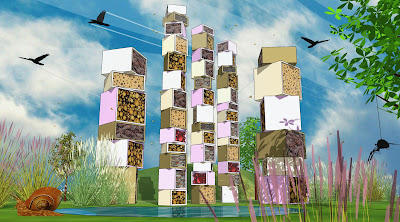Nesting blocks are simple wood structures that provide habitat for native bees. Bees typically nest inside of woody stems or underground. Nesting blocks can be made from a variety of materials (bamboo, paper straws, fallen logs), but I decided to work with standard pine lumber. Nesting blocks should always be constructed from untreated lumber. There are a variety of drill bit sizes that can be used to drill the holes (3/32" - 3/8"), and the holes should be 3 - 5 inches deep. Holes should be around 3/4" apart from one another. The cavities can be drilled directly into solid lumber, but maintenance of these blocks is more tedious. Drilling the holes in between planks of wood can be more time consuming during construction, but expandable nest block are easier to maintain, and help prevent the spread of disease among bees.
Wednesday, February 29, 2012
Native bee nesting block study model
Nesting blocks are simple wood structures that provide habitat for native bees. Bees typically nest inside of woody stems or underground. Nesting blocks can be made from a variety of materials (bamboo, paper straws, fallen logs), but I decided to work with standard pine lumber. Nesting blocks should always be constructed from untreated lumber. There are a variety of drill bit sizes that can be used to drill the holes (3/32" - 3/8"), and the holes should be 3 - 5 inches deep. Holes should be around 3/4" apart from one another. The cavities can be drilled directly into solid lumber, but maintenance of these blocks is more tedious. Drilling the holes in between planks of wood can be more time consuming during construction, but expandable nest block are easier to maintain, and help prevent the spread of disease among bees.
Tuesday, February 28, 2012
Moss Slurry and Square Tubing
This is an experiment in growing moss. I did a version before this attempt in which the buttermilk and moss slurry was applied to styrofoam, a shoe, and an old shirt and let to sit out in my kitchen; the result was a crusty dried-up failure. With the new attempt I made building blocks of bass wood each with a drilled hole and hung these (covered with moss slurry) inside a discarded veg. oil container. Maybe this will keep the humidity up. I would like to see each block with a robust moss covering which i can then combine into a larger study model. I will keep you posted
This is the layout of the hedge 6'x40' using 1" square tubing. I discovered late in the process that i had pulled the dimensions using Rhino incorrectly so the form will be slightly different than the planned form. I could still "fix" the problem but i have decided to use the screw up and will redraw the plans accordingly and post later.
Sunday, February 26, 2012
Friday, February 24, 2012
Thursday, February 23, 2012
Wednesday, February 22, 2012
Tuesday, February 21, 2012
Saturday, February 18, 2012
Friday, February 17, 2012
Bumblebee City Nesters - Fisher Tomlin
http://inhabitat.com/leading-architects-unveil-luxury-bug-hotels-in-london/the-bumblebee-city-nesters-at-west-smithfield/?extend=1
Thursday, February 16, 2012
Subscribe to:
Comments (Atom)


















































